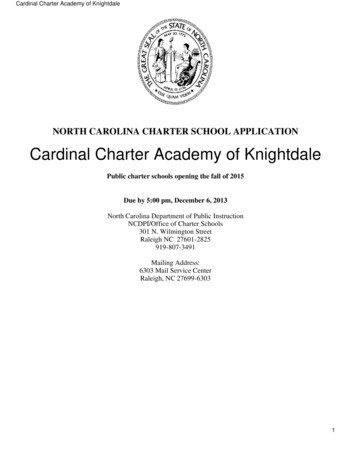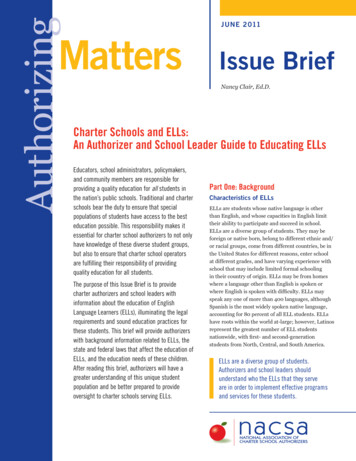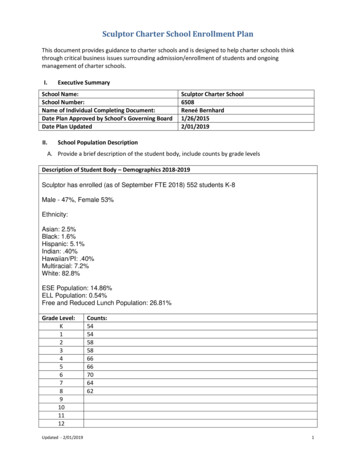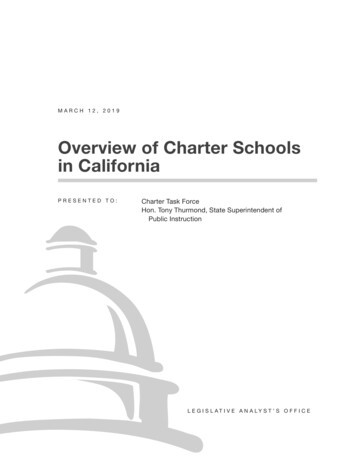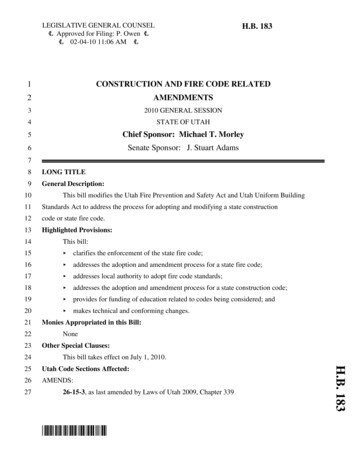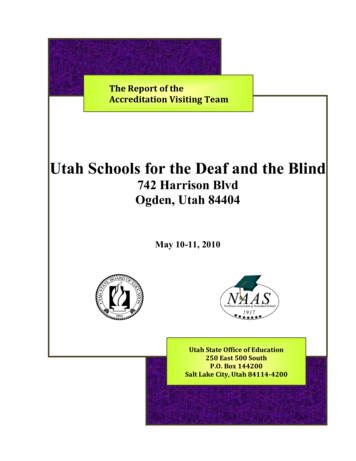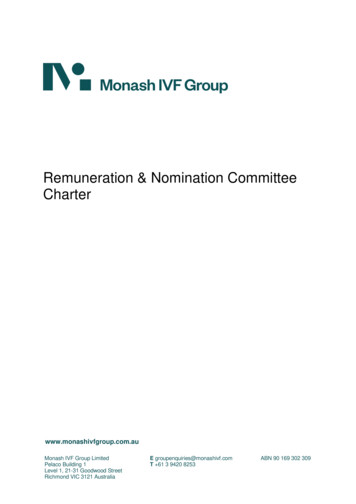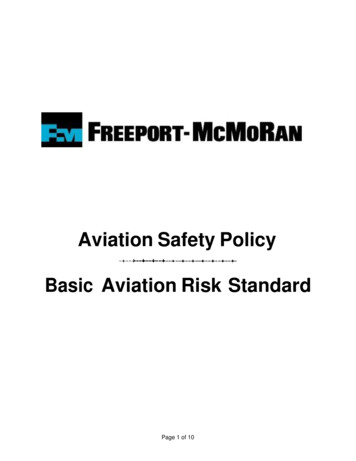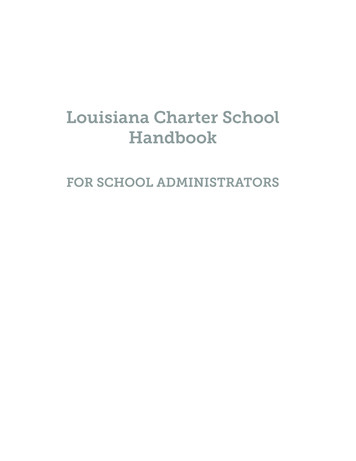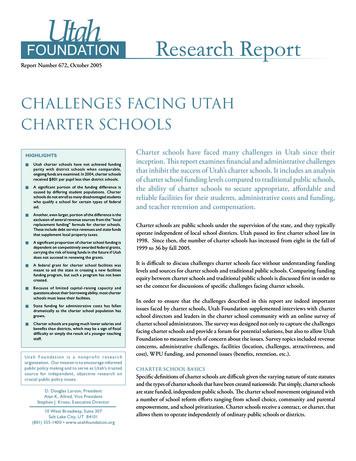
Transcription
Report Number 672, October 2005CHALLENGES FACING UTAHCHARTER SCHOOLSHIGHLIGHTS Utah charter schools have not achieved fundingparity with district schools when comparable,ongoing funds are examined. In 2004, charter schoolsreceived 801 per pupil less than district schools. A significant portion of the funding difference iscaused by differing student populations. Charterschools do not enroll as many disadvantaged studentswho qualify a school for certain types of federalaid. Another, even larger, portion of the difference is theexclusion of several revenue sources from the “localreplacement funding” formula for charter schools.These include debt service revenues and state fundsthat supplement local property taxes. A significant proportion of charter school funding isdependent on competitively awarded federal grants,carrying the risk of losing funds in the future if Utahdoes not succeed in renewing the grants. A federal grant for charter school facilities wasmeant to aid the state in creating a new facilitiesfunding program, but such a program has not beencreated. Because of limited capital-raising capacity andquestions about their borrowing ability, most charterschools must lease their facilities. State funding for administrative costs has fallendramatically as the charter school population hasgrown. Charter schools are paying much lower salaries andbenefits than districts, which may be a sign of fiscaldifficulty or simply the result of a younger teachingstaff.U t a h F o u nd at i o n i s a n o n p ro f i t re se a rc horganization. Our mission is to encourage informedpublic policy making and to serve as Utah’s trustedsource for independent, objective research oncrucial public policy issues.D. Douglas Larson, PresidentAlan K. Allred, Vice PresidentStephen J. Kroes, Executive Director10 West Broadway, Suite 307Salt Lake City, UT 84101(801) 355-1400 www.utahfoundation.orgCharter schools have faced many challenges in Utah since theirinception. This report examines financial and administrative challengesthat inhibit the success of Utah’s charter schools. It includes an analysisof charter school funding levels compared to traditional public schools,the ability of charter schools to secure appropriate, affordable andreliable facilities for their students, administrative costs and funding,and teacher retention and compensation.Charter schools are public schools under the supervision of the state, and they typicallyoperate independent of local school districts. Utah passed its first charter school law in1998. Since then, the number of charter schools has increased from eight in the fall of1999 to 36 by fall 2005.It is difficult to discuss challenges charter schools face without understanding fundinglevels and sources for charter schools and traditional public schools. Comparing fundingequity between charter schools and traditional public schools is discussed first in order toset the context for discussions of specific challenges facing charter schools.In order to ensure that the challenges described in this report are indeed importantissues faced by charter schools, Utah Foundation supplemented interviews with charterschool directors and leaders in the charter school community with an online survey ofcharter school administrators. The survey was designed not only to capture the challengesfacing charter schools and provide a forum for potential solutions, but also to allow UtahFoundation to measure levels of concern about the issues. Survey topics included revenueconcerns, administrative challenges, facilities (location, challenges, attractiveness, andcost), WPU funding, and personnel issues (benefits, retention, etc.).CHARTER SCHOOL BASICSSpecific definitions of charter schools are difficult given the varying nature of state statutesand the types of charter schools that have been created nationwide. Put simply, charter schoolsare state funded, independent public schools. The charter school movement originated witha number of school reform efforts ranging from school choice, community and parentalempowerment, and school privatization. Charter schools receive a contract, or charter, thatallows them to operate independently of ordinary public schools or districts.UTAH FOUNDATION, OCTOBER 20051
Figure 1: Utah’s Charter SchoolsCharter SchoolDistrictGraniteAcademy for Math, Engineering& Science (AMES)American Leadership AcademyNeboAmerican Preparatory AcademyJordanBeehive Science & TechnologyGranite/Academy (BSTA)Salt LakeCBA CenterMillardCity AcademySalt LakeDaVinci AcademyOgden/WeberEast Hollywood HighGraniteEntheos AcademyGraniteFast ForwardLoganFreedom AcademyProvoGeorge Washington AcademyWashingtonItineris Early College High SchoolJordanJohn HancockAlpineLakeview AcademyAlpineLegacy Preparatory AcademyDavisLincoln AcademyAlpineMoab Community SchoolGrandMountainville AcademyAlpineNavigator Pointe AcademyJordanNoah Webster AcademyAlpineNorth Davis Preparatory AcademyDavisNorth Star AcademyJordanNorthern Utah Academy forDavis/Math, Engineering and SciencesOgden/(NUAMES)WeberOdyssey Charter SchoolAlpineOgden Preparatory AcademyOgdenParadigm High SchoolJordanPinnacle Canyon AcademyCarbonRanches AcademyAlpineReagan AcademyNeboRenaissance AcademyAlpineSalt Lake Arts AcademySalt LakeSoldier HollowWasatchSouth Ridge AcademyJordanSpectrum AcademyDavisSUCCESS AcademyIronSuccess SchoolGraniteSummit AcademyJordanThomas Edison CharterCacheSchool-NorthThomas Edison CharterCacheSchool-SouthTimpanogos AcademyAlpineTuacahn High School for theWashingtonPerforming ArtsUintah RiverUintahAlpineUtah County Academy ofSciences (UCAS)ProvoWalden School of Liberal ArtsDavisWasatch Peak AcademySchools Currently in OperationSchools Approved for 2006 OpeningTotal Charter Schools Approved361046GradesTaught9-12Numberof StudentsApproved for250Opening DateFall 2003K-12K-97-81275530150Fall 2005Fall 2003Fall 552550048084675515525525450500Fall 1999Fall 2000Fall 2004Fall 2004Fall 2006Spring 2003Fall 2003Fall 2006Fall 2004Fall 2002Fall 2006Fall 2006Fall 2005Fall 2004Fall 2006Fall 2005Fall 2006Fall 2004Fall 2005Fall -737555050034036067560024390650150200200525417Fall 2005Fall 2003Fall 2006Fall 1999Fall 2004Fall 2005Fall 2006Fall 2003Fall 1999Fall 2006Fall 2006Fall 2005Fall 1999Fall 2004Fall 2002K-7324Fall 2005K-89-12505210Fall 2002Fall 19999-1210-1280200Fall 1999Fall 20057-10K-690350Fall 2004Fall 200512,5934,92517,518Source: Utah State Office of Education (USOE), Utah Charter Schools AssociationAs public schools, charter schools cannot charge tuition and arerequired to enroll all eligible students who submit applications (if theschool has room for them); Utah charter schools are forbidden fromaccepting students based on merit or ability. If more students applythan enrollment space will allow, charter schools must determineadmission in an equitable manner such as a lottery. Charter schoolsare, however, allowed to give admission preferences to studentswhose parents are or were actively involved in starting the school orthose who have siblings currently enrolled. Utah law also allows apreference for students who reside near the school; however, charterschools that choose to give preference to students residing nearby arenot eligible to receive certain federal funds or grants, and none haveimplemented this preference.Minnesota developed the nation’s first charter school law in 1991based on three central tenets: opportunity, choice and schoolresponsibility for results.1 Principles guiding Utah’s public charter2UTAH FOUNDATION, OCTOBER 2005schools include providing educational diversity and choice inschools and encouraging the development of unique educationalopportunities.2 Charter school legislation first passed in Utah in1998, and the majority of Mountain West states have followed suitincluding Nevada, Idaho, Wyoming, Colorado, New Mexico andArizona. Currently, 42% of all U.S. charter schools are located inArizona, California, and Florida.3Today, over 40 states, the District of Columbia, and Puerto Ricohave charter school enabling legislation, and the number of schools inexistence totals over 3,400. For the past school year, 2004-2005, morethan 400 new charter schools opened in 32 states.4 Approximately1.5% of all students nationwide are enrolled in charter schools.5 InUtah’s 2005 legislative session, Senate Bill 178 passed, removingthe cap on the number of charter schools that can open each yearin Utah, signaling a potential for increased growth rates for Utahcharter schools.6Charter schools in Utah are monitored by the State Charter SchoolDirector and the State Charter School Board, with ultimate authorityover them residing with the State School Board. The State CharterSchool Board is responsible for the authorization of new charterschools as well as annual reviews of performance of existing charterschools. The State Charter School Board monitors schools to ensureadherence to local, state and federal regulations and is involved in thelegislative process pertaining to charter schools. In addition, otherstaff at the Utah State Office of Education are frequently involved incharter school oversight and training, including financial reporting,legal issues, personnel issues, and others.Despite the national charter school movement’s emphasis onderegulation of schools, charter schools in Utah are subject to nearlyall of the requirements that apply to regular public schools. Thisincludes reporting, testing, hiring, spending, and core curriculum.7Charter schools may petition the State Board of Education forexemption from some requirements, but such exemptions are rare.Failure to adhere to required regulations or poor performance mayresult in the loss of a charter. Charter schools also must conform tofederal regulations and accounting rules common to other publicagencies or groups receiving public funds.While charter schools operate as public schools, there are severalnotable differences between charter schools and district schools.Charter schools generally place greater emphasis on parent, student,and faculty involvement in school governance. It is not uncommon forparental or educational advocacy groups to establish a charter school.While parental involvement is commonly considered a cornerstoneof charter school establishment, schools are not legally allowed tomake it a requirement (or tie parental involvement to admission fortheir children).While charter schools in Utah are required to follow the samebasic state education guidelines, charter schools have the ability topursue unique education missions. Some schools serve special needsWWW.UTAHFOUNDATION.ORG
populations, while other schools serve student populations who havehad academic or disciplinary problems in traditional public schools.Other schools integrate a subject-specific emphasis into the state corecurriculum such as performing arts, fine arts, or environmental issues.Many schools focus on traditional academics, using curricula thatare similar to private schools.A trend in recent years is the emergence of early college and high-techhigh school charter schools, with the stated goal of providing highschool students more access to college level course material as wellas recruiting more students into math and science-based fields. TheAcademy for Math, Engineering and Science (AMES) in Salt LakeCity was the first of these charter high schools to open.8 As part offormer Governor Leavitt’s New Century High School Initiative,AMES provides high school students with increased access to math,science, technology, engineering, and computer science courses, whilestill offering core classes in social sciences, languages, and the arts.The charter school enabling legislation in Utah was designed withseveral purposes in mind. These purposes may be a helpful context inwhich to analyze the equity of charter school funding and facilitiesissues. According to the Utah Charter Schools Act9, the purposes ofcharter schools are to:1. Continue to improve student learning;2. Have the ability to serve the needs of special needspopulations;3. Empower schools to focus more on education results thancompliance with regulations; and4. Relieve pressure on high enrollment growth districts byproviding additional schools for new students to attend.Figure 2: FY 2004 Charter School Funding by Source Local10.4%Federal16.6%State72.9%Source: USOEFigure 3: FY 2004 Districts Funding by Source 2. Encourage the use of different and innovative teachingmethods;3. Create new professional opportunities for educatorsthat will allow them to actively participate in designing andimplementing the learning program at the school;4. Increase choice of learning opportunities for students;5. Establish new models of public schools and a new form ofaccountability for schools that emphasizes the measurementof learning outcomes and the creation of innovativemeasurement tools;6. Provide opportunities for greater parental involvement inmanagement decisions at the school level; and7. Expand public school choice in areas where schools havebeen identified for school improvement, corrective action,or restructuring under the No Child Left Behind Act of2001, 20 U.S.C. Sec. 6301 et seq.In addition to the purposes set forth by the state, individuals in thecharter school arena have suggested that charter schools also:1. Encourage market-type competition between traditionalschools and charter schools, creating an incentive forincreasing school performance;Local34.3%State58.4%Federal7.3%Source: USOEUTAH’S SCHOOL FUNDING SYSTEMPublic schools in Utah receive revenue from three main sources:the federal government, the state government, and local revenuesgenerated by their own property tax levies. Figures 2 and 3 depict thepercentages of funding levels for both charter schools and districts.Federal revenues for charter schools approach 17%, but are only7% for districts10. Roughly 73% of charter school revenue is fromstate sources, as compared to 58% for districts. Charter schools areunable to capture local revenues in the same way districts can (i.e.levy property taxes). More than one-third of district funding is fromlocal revenue sources—namely property tax. Each of these revenuecategories will be discussed in more detail below.11Feder al FundingAs noted above, charter schools rely on federal funding at nearly twicethe rate of traditional districts as seen in Figure 2. Most federal moneyUTAH FOUNDATION, OCTOBER 20053
comes in the form of grants and NCLB funds for students in highpoverty schools and food service programs, as well as Individuals withDisability Education Act (IDEA) special education funding.12There are three potential avenues in which charter schools can receivefederal grants: under the Public Charter Schools Program (PCSP),the State Charter School Facilities Incentive Grants Program and theCredit Enhancement for Charter School Facilities program. Utahcurrently receives funding from two of these programs: the PCSPand the Facilities Incentive Grants Program.Public Charter Schools Program (PCSP)Under the PCSP, approximately 1 billion has been awardednationally to charter schools since 1994.13 The PCSP was designedto increase the number of quality charter schools. Charter schoolsare eligible to receive PCSP grant monies for three years in order tooffset start-up costs incurred during their first years of operations.The grant money must be used to offset costs incurred for obtainingeducation materials and supplies, developing curriculum, and otherlimited operational costs. PCSP grant money is designed to serve asa reimbursement for monies already spent by charter schools. It ispossible, however, to request disbursement of grant money withouthaving incurred any start-up or implementation costs so long as thegrant money is spent within 30 days of receipt.14 States agenciesreceiving PCSP grant monies are allowed to retain up to five percentof grant monies to offset charter school administrative costs and 10%of their grant monies to support dissemination activities.15State Charter School Facilities Incentive Grants ProgramCharter schools are also able to receive grant monies under the StateCharter School Facilities Incentive Grants Program which began inFY 2004-2005. Implemented under the Elementary and SecondaryEducation Act and amended by the No Child Left Behind Act(NCLB) Act of 2001, the Facilities Incentive Grants Program isdesigned to encourage states to expand facilities and to help sharein the costs associated with charter school facilities. Through theDepartment of Education, states compete for grants of up to fiveyears in length. In order for states to be eligible to compete for grants,they must have a program currently in place and specify in statelaw a provision for per-pupil funding on an annual basis for charterschool facilities. Over the five year period, grant funds diminish eachyear until they are entirely phased out.16 States that meet certainrequirements are given preference in the award process. Examplesof preferential criteria include states that provide for evaluations andreviews of charter schools by a centralized board or agency every fiveyears and states that demonstrate increasing progress in the numberof quality charter schools.Funding for these grants is contingent upon sufficient resources. Totalappropriations for the Public Charter Schools Program must exceed 200 million in order for grants to be available to states. When morethan 300 million is appropriated to the program, half of the amountover 300 million must be used for the Facilities Incentive GrantsProgram. The total money appropriated nationally for the grants for4UTAH FOUNDATION, OCTOBER 2005Fiscal Year 2004 was 18.7 million.17Utah was one of only four states thus far to receive a federal grantunder the State Charter School Facilities Incentive Grants Program.For Fiscal Year 2005, the Utah State Office of Education received 2,785,655 from this grant. The funds are used to match a portionof the property tax replacement funding provided to charter schoolsby the state. Following state law, at least 10% of the property taxreplacement money must be used for charter school facilities.This report focuses on budgetary data for FY 2004, which was thelatest final data available at the time of this analysis. In FY 2005,this grant added 427 per pupil to charter school revenues; however,the per-pupil value of this grant will decline as the charter schoolpopulation grows and the federal revenue phases down. Otherrecipients include: California ( 9.85 million), Minnesota ( 5 million)and the District of Columbia Public Schools ( 1.05 million).18Credit Enhancement for Charter Schools Facilities ProgramUnder the Credit Enhancement for Charter Schools FacilitiesProgram, state and local education agencies and nonprofitorganizations are able to compete for funds to secure facilities eitherthrough an outright purchase, lease, or donation. The funds can alsobe used to construct or renovate facilities.19 Support for this programis contingent upon appropriation of funds. Organizations that receivecredit enhancement grants are able to provide charter schools withleverage to acquire capital for new construction or renovation ofcurrent facilities.Currently, no Utah organization is a recipient of a CreditEnhancement Grant, though organizations have submittedapplications in the past. Charter schools can apply individually,but the U.S. Department of Education encourages schools to seekservices from current grantees rather than applying directly. Grantapplicants must be able to demonstrate substantial expertise ininvestment banking to successfully implement their proposals toprovide credit enhancement to schools. Although Utah charterschools may apply for assistance from national groups who areparticipating in this program, none of Utah’s charter schools havereceived funds from this program.Adequacy of Feder al Start-Up Gr antsBased on Utah Foundation survey results, charter school leaders aredivided on the adequacy of federal start-up grants. Forty percentof respondents felt that federal start-up grants were ample andprovided for needed equipment and supplies. This means that 60%of respondents felt the amount of federal start-up grants they receivedwere at least somewhat deficient and prevented them from equippingtheir schools in the same manner as traditional public schools.Federal start-up grant funds are provided to the state, which thengrants the money to new charter schools during their first threeyears of operation. Utah Foundation examined grant data forcharter schools that had passed their third year of operation toWWW.UTAHFOUNDATION.ORG
understand how they spent their start-up grants over their threeyear implementation period.20 The average amount received by acharter school during those three years was about 540,000. Figure4 shows how those schools spent their start-up funds. Note that morethan two-thirds of the grant money was spent on property (schoolequipment) and supplies. New charter schools also spent some ofthe grant funds for personnel costs, professional services, and otherservices related to the opening of a new school.Figure 4: 3-Year Average Usage of Federal Start Up Grants Salaries11.6%Property36.0%Employee Benefits1.9%%Professional& Technical Services8.9%Property Services 3.2%Other Services 2.1%Travel 1.4%Other DirectCosts 2.3%Supplies & Materials32.4%Other IndirectCosts 0.3%To provide an indication of the adequacy of these start-up grants,Utah Foundation asked Alpine School District, which has openednew schools in recent years, to describe its start-up costs for a newelementary school.21 The district provided details on its spendingfor equipment and supplies, but spending for personnel or servicesassociated with opening a new school was not available.22 The AlpineSchool District budgets around 480,000 to be spent on equipmentand supplies when opening a new school. The data from charterschools show about 370,000 spent on equipment and supply needs.The federal PCSP grants provide a valuable source of funding forcharter school start-up needs, but some concerns about this fundingare evident:First, these funds are limited, at least compared to Alpine SchoolDistrict, which has experienced significant growth. Additionally, asthe number of charter schools has grown, the amount provided instart-up grants has diminished markedly. Several years ago, some ofthe new charter schools received more than 600,000 cumulativelyover three years for implementation costs. New charter schools arenow limited to 150,000 a year, or 450,000 over three years.schools, reducing the amount that any one school will receive.Local RevenueSchool districts can levy property taxes for 13 different programs.These programs include: minimum basic levy, capital outlay, debtservice, voted leeway, board leeway, 10 percent additional basic, votedcapital outlay leeway, federal impact aid supplement, recreation,special transportation, tort liability, judgment recovery and theK-3 Reading Program. Charter schools do not have boundaries ortaxing authority and so are unable to levy property taxes for theseprograms. Until 2003, districts provided to charter schools 50% oftheir per-pupil local property tax revenue for the number of pupilsenrolled in charter schools. In 2003, the Legislature enacted changesthat allow districts to retain all local revenues derived from propertytax collection and created ‘local replacement funding’ for charterschools. This will be discussed in more detail below.State RevenueThe largest portion of revenue for education is derived from statesources, mainly the Uniform School Fund, which is funded primarilythrough personal and corporate income taxes. Governed by theMinimum School Program Act (MSP), the state distributes fundsto districts and charter schools using a myriad of formulas based onenrollment, student characteristics and school location. The relevanceof these programs and allotment formulas to charter schools willbe explained in more detail below. The MSP is designed in part toequalize funding capacity between poorer and richer districts.23 TheBasic Program provides support to all public schools for students ingrades K-12. The basis for distribution of this program is the WeightedPupil Unit, or WPU.Weighted Pupil Unit: WPUWeight Pupil Unit (WPU) is a measurement unit calculated accordingto program specific formulas usually involving prior year average dailymembership (ADM) plus growth. The Legislature determines the dollarvalue of the WPU annually during the General Session. How many WPUsa district or charter school generates is contingent upon various studentcharacteristics. For charter schools, Kindergarten students generate 0.55WPUs, students in grades 1-6 generate 0.9 WPUs, grades 7-8 generate 0.99WPUs, and grades 9-12 generate 1.2 WPUs. One WPU for FY 2003-2004was 2,150; for FY 2006 it is valued at 2,280.Second, Utah has recently succeeded in winning renewal of the PCSPgrants for the coming three years, but significant risk exists for futureyears. The PCSP is a competitive grant program, and the time maycome when Utah does not receive these grant funds. It would beextremely difficult to start new charter schools without millions ofdollars in state funding to compensate for lost federal grants.Under the MSP, every district in the state must levy the basicminimum property tax rate in order to qualify for funding from thestate’s Uniform School Fund. The basic levy rate is applied uniformlyto all districts statewide. The more revenues an individual districtreceives from the levy, the less revenue that district receives from thestate. School districts are also then able to impose levies in additionto the basic rate. As discussed above, charter schools do not have theability to levy taxes.Third, as with some of the other funding mechanisms for charterschools, this funding source diminishes in value as a larger number ofcharter schools open each year. The funds must be spread among moreIn lieu of charter schools collecting property taxes or receivingfunding from individual school districts, the state of Utah providescharter schools with local replacement funding, sometimes referredUTAH FOUNDATION, OCTOBER 20055
to as property tax replacement funding.24 At the time of this report,the FY 2006 local replacement funding rate for charter schools is 1,051 per student, an increase of 45 per student from FY 2005.While charter schools have discretion in what this funding can beused for, 10% of all charter school local replacement funding mustbe spent to offset facilities costs.While the MSP provides funding for the majority of educationalactivities, there are some limitations on what the money can beused for. Regular Basic School Program funding can be usedfor any educational purpose. Restricted Basic School Programfunding must be used for the specific programs for which they areearmarked. Related to Basic Program funding is designed exclusivelyfor retirement, transportation, Social Security, and other programs.Additional MSP funding is categorized as Special Populationsfunding, which is limited to funding activities for given populationsof students, and Other Programs which provide unrestricted fundingfor programs such as electronic high schools and school land trustprograms.25 Figure 5 shows which programs within the MinimumSchool Program receive funding based on WPUs.26Figure 5: Utah Minimum School ProgramBasic School ProgramsFunding GeneratedRegular Basic School ProgramsKindergartenGrades 1-12Necessarily Existent Small Schools*Professional StaffAdministrative CostsWPUWPUWPUWPUWPURestricted BasicSpecial Education**Pre-school Special EducationExtended Year for Severely DisabledSpecial Education--State ProgramsApplied Technology Education--DistrictApplied Technology Education--District Set AsideClass Size ReductionRelated to Basic School ProgramsWPUWPUWPUWPUWPUWPUFunding GeneratedRelated to BasicSocial Security & RetirementPupil Transportation To & From SchoolTransportation LevyWPUBlock GrantsQuality Teaching Block GrantLocal Discretionary Block GrantInterventions for Student Success Block GrantSpecial PopulationsHighly Impacted SchoolsYouth At Risk Adult EducationAccelerated Learning Program OtherElectronic High SchoolSchool Land TrustCharter School in Lieu of Local FundingUniversity of Utah Reading ClinicReading Achievement--StateFigure 6: FY 2004 Funding Comparison by Revenue SourceTotal DollarsFunding SourceAll ChartersAll DistrictsMAINTENANCE& OPERATIONLocal Sources 1,948,151 496,698,958Property Taxes10433,750,489Earnings on Investments5,73110,472,581Contributions& fferencePer PupilCharters Charters Districts Districts 59802 1,03890622- 440-906-203452510109344142State SourcesRegular Basic Program3Restricted Basic ProgramSpecial Education4Class Size ReductionApplied TechnologySocial Security& RetirementState Block Grants5Special PopulationsAt-Risk RegularOther At-RiskAccelerated LearningGifted & TalentedOther AcceleratedLearningTransportation6School Land TrustBoard and VotedLeeway GuaranteesCharter School LocalReplacementMiscellaneous7Other8 13,599,4027,091,759 1,580,671,822762,281,414 4,1722,175 3,3021,592 22,722,0278,092,4297961415904717796-33142Federal SourcesCharter School Start-UpGrants (PCSP)Other Federal 3,103,323 197,441,993 952 412 5392,497,021606,3020197,441,9937661860412766-226 18,650,876 2,274,812,773 5,721 4,752 969 16,153,855 2,274,812,773 4,955 4,752 2030195,011,0160407-40702,106,40904-4 0 197,117,425 0 412- 41200228,410,21223,627,354004774
While charter schools in Utah are required to follow the same basic state education guidelines, charter schools have the ability to . DaVinci Academy Ogden/Weber 9-12 Fall 2004 East Hollywood High Granite 9-12 Fall 2004 Entheos Academy Granite K-8 Fall 2006 Fast Forward Logan 9-12 Spring 2003
